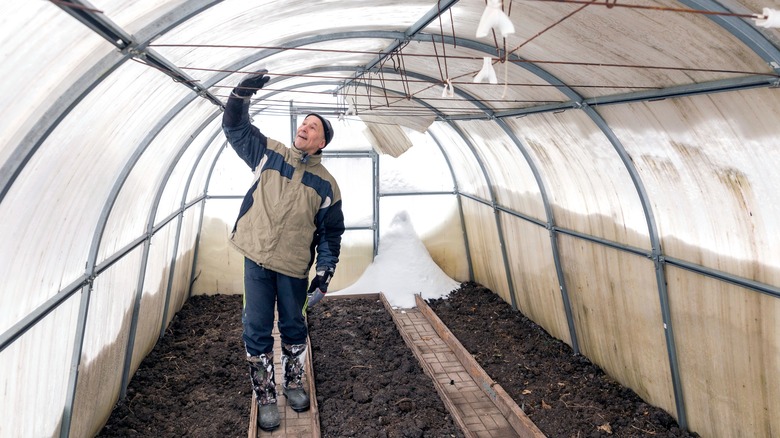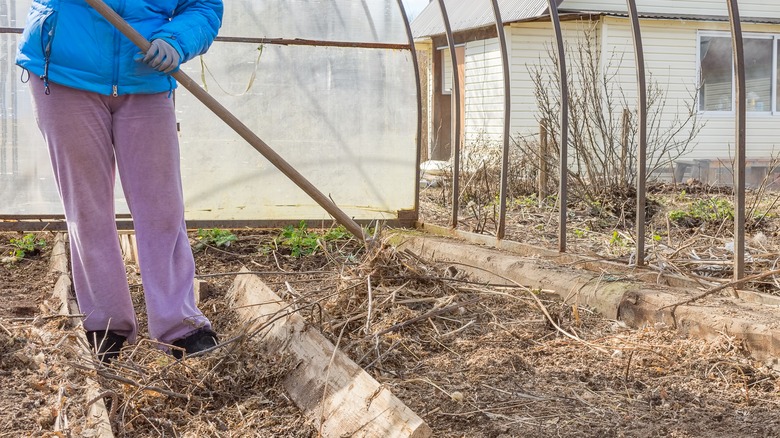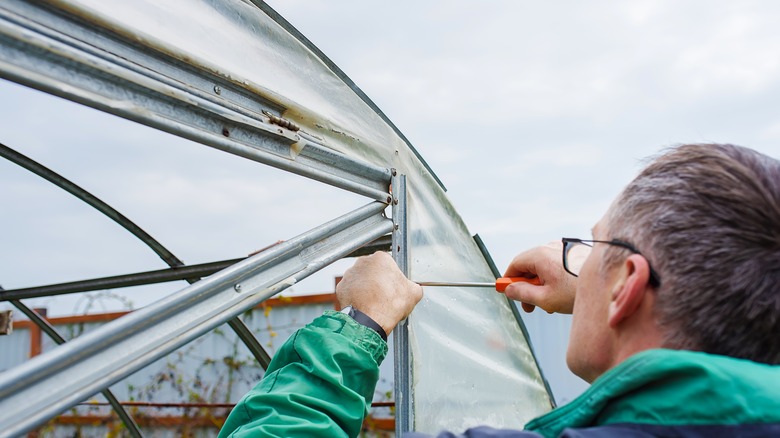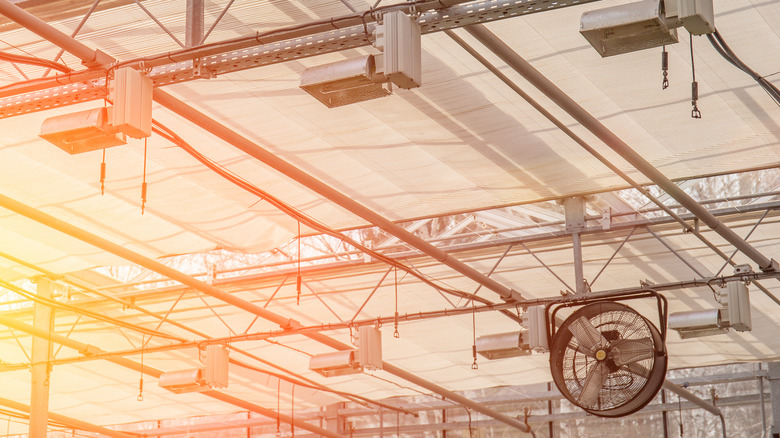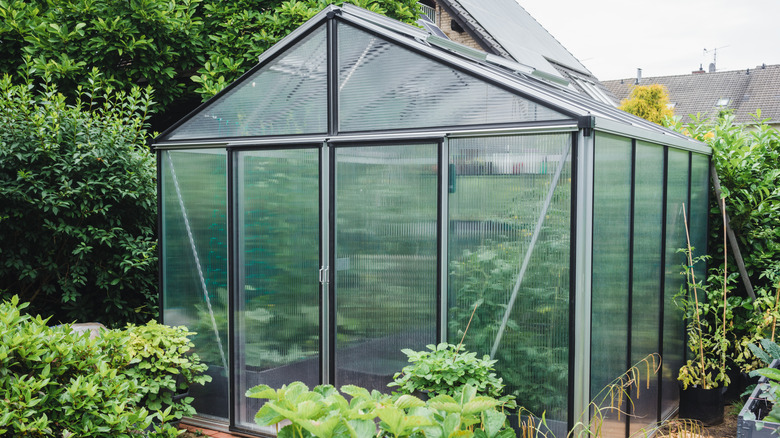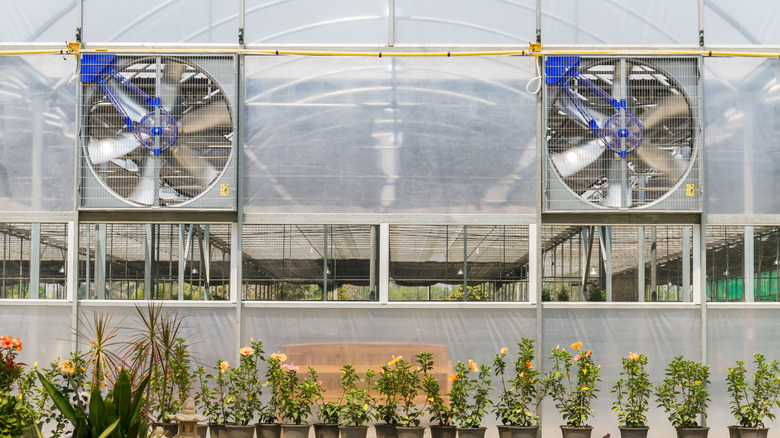5 Tips For Prepping Your Greenhouse For Winter
When October arrives, it goes without saying that winter is just around the corner, and if you're an avid gardener, that means you're almost running out of time for prepping your greenhouse for plummeting temperatures. For most people, the ideal growing season is right after winter frost to the beginning of fall frost, according to WeatherBug. In fact, with the bountiful harvest during summer, it's easy to forget the greenhouse needs some care and maintenance right before winter sets in, too.
You'll be glad you prepped your greenhouse for the winter once spring begins again and the growing season resumes. The feeling of walking into a clean and perfectly organized greenhouse right after winter is gone is unmatched. However, for those who are considering growing cold hardy plants during winter, prepping the greenhouse goes a long way in making sure the plants make it through this season as well. So how do you winterize your greenhouse? Well, you'll be surprised to find out that winterizing your greenhouse is easier than you think. Here are a few pointers that should get you started.
Give it a good old cleaning
Cleaning your greenhouse during fall gives you the opportunity to organize and also keep everything working efficiently. However, while that's true, your approach to cleaning the greenhouse should be informed by two reasons: whether you're considering growing crops during winter or you're simply prepping for the next season. So if you're considering growing cold hardy plants all through winter, you might not have a lot to do as far as cleaning. All, you have to do is to make sure the equipment is working well and the walls are clear to allow enough light in. However, if you're done for the season and are prepping for spring, you have some clean-up to do.
First, get rid of all the plants and also take out every piece of equipment from the greenhouse. Using a brush, give the walls, ceiling, and floor some good old scrubbing. Be sure to reach into those tight corners to remove pests like snails that are hidden away. Once you're done, be sure to disinfect the greenhouse and all the equipment that was in it. The UMass Center for Agriculture, Food, and the Environment recommends disinfecting the greenhouse in between growing seasons, particularly when it's empty. Disinfecting the greenhouse is a good practice for managing pathogens for the most part.
Inspect and do some repairs
In order for your greenhouse to perform efficiently during winter, you need to make sure the structures both inside and outside are in tip-top condition. The first place to inspect should be the glazing; you need to make sure that there are no holes or cracks. Remember, even the tiniest of holes will allow cold air in, making your heating system overwork which, will be costly in energy bills, (via Newair). Also, getting ahead of the problem early enough will prevent the issue from snowballing into a major repair that will be costly to fix.
There's no better time to do the inspection than fall when the weather is still conducive. No one wants to leave the comfort of their cozy home to go out and repair the greenhouse in freezing temperatures. Walk around and patch up the smaller holes and cracks; anything that cannot be fixed by caulk will require you to replace the covering material. Also, this is the perfect time for making sure the doors are lockable and the hinges are working properly. Oil the hinges and repair the door locks, to make them more operable even after the temperature drops.
Ensure the heating system is working properly
Making sure the heating system in your greenhouse is working efficiently is necessary, especially if you have the intention of growing hardy plants during winter. Essentially, the heating system should be maintained all year-round. However, fall presents the perfect opportunity for making sure everything checks out right before the cold weather sets in. According to the Center for Agriculture, Food, and the Environment at UMass Amherst, servicing the heating system in preparation for winter not only helps keep your plants alive but also saves you up to 20% in fuel consumption.
There are several ways of heating the greenhouse; however, the best heating system is the one that provides suitable temperature control without releasing harmful substances to the plants. A good repair person should be able to check and make sure everything works fine. It's also worth mentioning that having a backup electric heater is a good idea, just in case of a power outage during a winter storm.
Provide insulation
Do not underestimate the winter temperatures. In addition to heating up the greenhouse, you also need to make sure the heat remains inside. One way of making sure this happens is by fixing every hole or crack on the covering material. As mentioned earlier, patching up the holes with heat-retaining caulk will be sufficient most of the time. Another option that's worth exploring is using energy curtains, especially if you're growing plants during winter. They will provide that extra insulation that'll go a long way in maintaining the temperatures within the acceptable range.
It's also necessary to note that heat loss via the greenhouse foundation is another source of energy loss that's not talked about often enough. According to Greenhouse Emporium, greenhouses lose up to 15% of heat through the ground during winter. Preventing heat loss through the ground is necessary, especially if you have plants grown directly in the soil. The best way of avoiding heat loss through the foundation is to build the greenhouse with the right foundation. However, if this is not an option for you at the moment, you can salvage the situation by installing ground insulation around the greenhouse perimeter.
Ensure proper ventilation
During winter, heating and ventilation in the greenhouse go hand in glove. You cannot have one without the other, especially if your intention is to grow plants during this season. However, the conditions outside won't just allow you to fling the greenhouse doors open for that much-needed fresh air. For that reason, it's necessary to have a ventilation system that'll remove the moisture-laden air outside. According to the University of Florida IFAS Extension, high humidity levels of over 90% create the perfect breeding ground for fungal diseases.
Also, note that the ventilation system settings aren not the same for every greenhouse every time. Sometimes, there might be a need for speedy air changes, especially when the temperature gets above 80 degrees F. Another point worth noting is that as the ventilation rate increases, so does the heating requirement. Remember, the ventilation system removes the warm moist air and replaces it with heated air from outside. So it's necessary to find that sweet spot where the ventilation rate maintains optimum humidity with minimal energy requirements.
